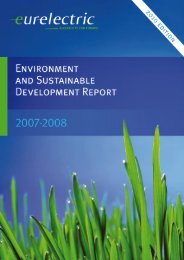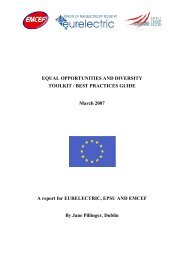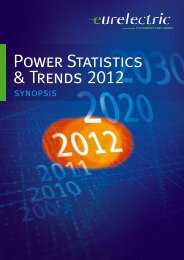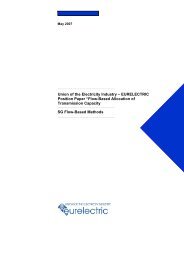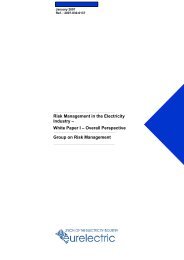Power Statistics - 2010 Edition - Full Report - Eurelectric
Power Statistics - 2010 Edition - Full Report - Eurelectric
Power Statistics - 2010 Edition - Full Report - Eurelectric
You also want an ePaper? Increase the reach of your titles
YUMPU automatically turns print PDFs into web optimized ePapers that Google loves.
Generation Trends<br />
Installed capacity vs. electricity generation:<br />
independent trends<br />
Figure 9 clearly reveals the importance of the capacity factor<br />
of generating capacities. Different generation sources have<br />
different capacity factors, which are influenced by the type of<br />
resource used, the technology, etc. 3 Therefore, the shares of<br />
installed capacity for different technologies do not necessarily<br />
translate into the same shares in electricity production.<br />
Thus, although nuclear represented roughly one sixth of total<br />
generating capacity in 2008, its actual share of electricity production<br />
Figure 9: Installed capacity vs. electricity generation<br />
Installed Capacity in 2008<br />
Other Renewables<br />
11%<br />
Hydro<br />
17%<br />
A new, less carbon-intensive mix emerges<br />
Figures 9 and 10 give an overview of the development of<br />
electricity generation in the EU-27 between 1980 and 2008, as<br />
well as indications of future expected production. While nuclear<br />
production has stabilised in the last decade, fossil-fuel fired and<br />
RES generation have increased their respective shares in 2008.<br />
Thus, between 2000 and 2008, conventional thermal production<br />
increased by just 13 % to 1,729 TWh, while RES generation –<br />
mainly driven by wind – experienced a real boom, increasing by<br />
240 % to reach 226 TWh. Carbon-free electricity thus accounted<br />
for roughly 46 % of total generation in 2008.<br />
Figure 10: Evolution of electricity production in the EU-27<br />
Electricity Production 2020 (TWh)<br />
Other Res<br />
17%<br />
Hydro<br />
10%<br />
Not Specified<br />
0%<br />
Nuclear<br />
16%<br />
Fossil Fuel Fired<br />
56%<br />
Not Specified<br />
1%<br />
Nuclear<br />
26%<br />
Conventional Thermal<br />
46%<br />
was almost one third, since nuclear power plants are commonly<br />
run in base-load mode. By contrast, hydro capacities in the EU-27,<br />
which represented a similar share of generating capacity, yielded<br />
lower values of electricity production due to the several different<br />
running modes of hydro power plants. The low capacity factor of<br />
wind and solar (grouped under ‘other renewables’ in Figure 9)<br />
translated into relatively low electricity generation figures compared<br />
to installed capacity. However, this discrepancy does not apply to<br />
biomass plants, which tend to run in base-load or mid-merit mode.<br />
Electricity Generation in 2008<br />
Other Renewables<br />
7%<br />
According to the assumptions of EURELECTRIC members (Figure<br />
10), low-carbon generation sources such as RES, hydro and<br />
nuclear will constitute the major generation source by 2020,<br />
delivering more than 2,000 TWh, compared to 1,692 TWh from<br />
fossil fuels (53 % vs. 46 %). Low-carbon generation sources<br />
will continue to dominate the generation mix thereafter, thanks<br />
to a major increase of RES in electricity generation, as well as<br />
an increase in nuclear production. The data for 2030 show<br />
low-carbon electricity generation reaching some 60 % of total<br />
electricity production.<br />
3 The capacity factor of a power plant is the ratio of the actual electricity produced in a given period to the hypothetical maximum possible,<br />
i.e. its output if it had continuously operated at full nameplate capacity.<br />
Hydro<br />
11%<br />
Electricity Production 2030 (TWh)<br />
Other Res<br />
22%<br />
Hydro<br />
9%<br />
Not Specified<br />
1%<br />
Nuclear<br />
28%<br />
Fossil Fuel Fired<br />
53%<br />
Not Specified<br />
0%<br />
Nuclear<br />
29%<br />
Conventional Thermal<br />
40%<br />
<strong>Power</strong> <strong>Statistics</strong> – <strong>2010</strong> <strong>Edition</strong> 17



